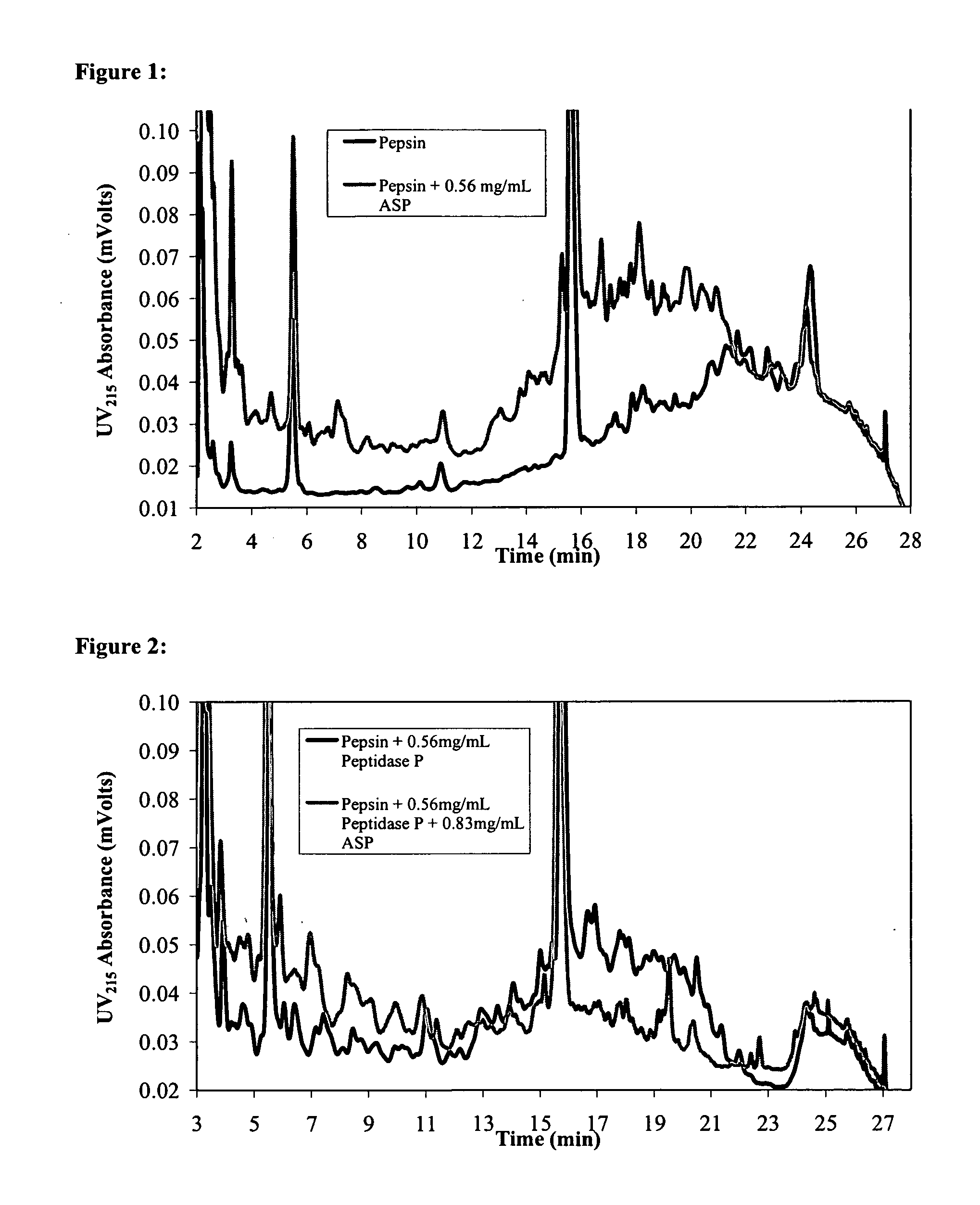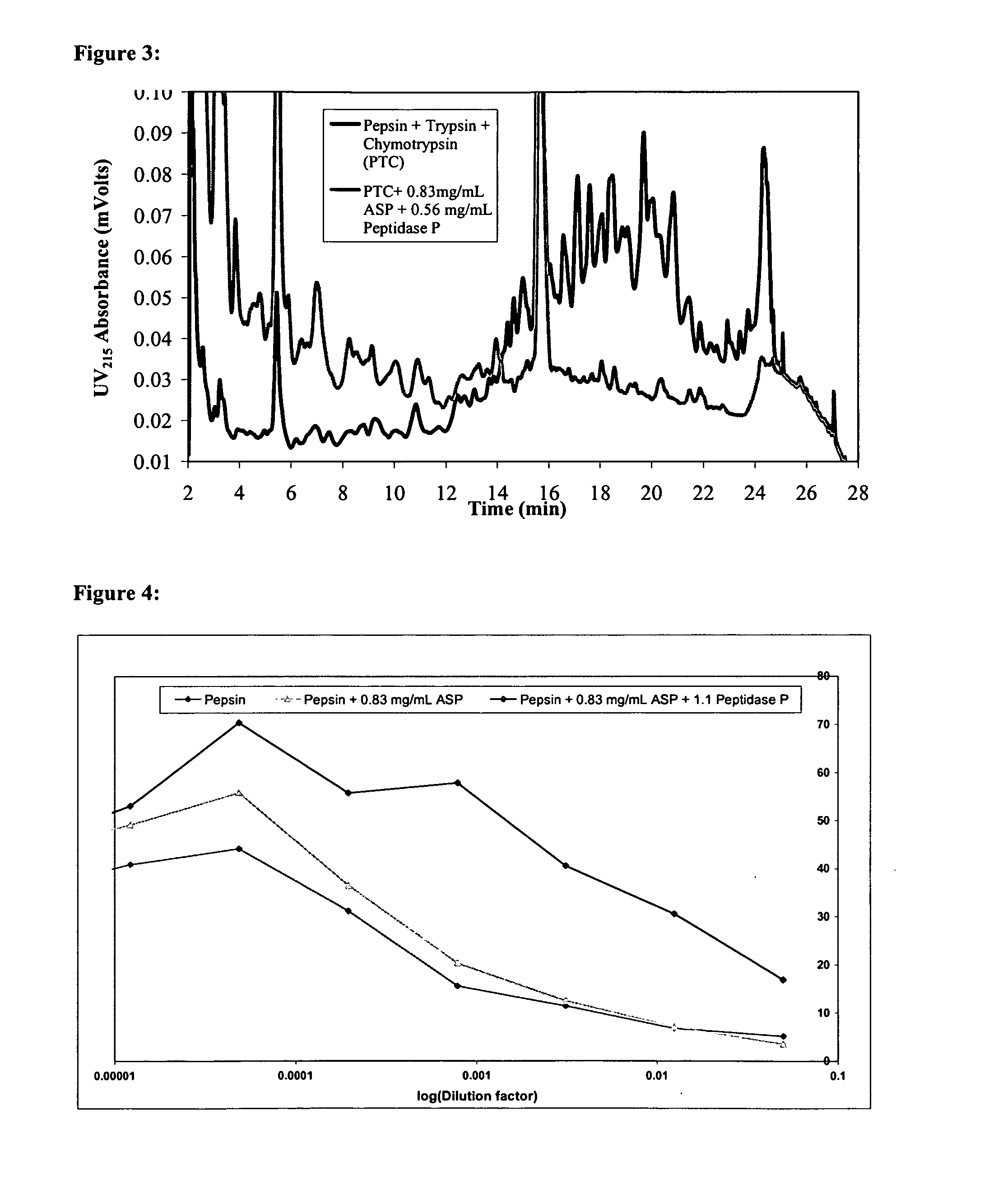Combination Enzyme Therapy for Gastric Digestion of Dietary Gluten in Celiac Sprue Patients
a technology of dietary gluten and enzyme therapy, which is applied in the direction of digestive system, drug composition, peptide/protein ingredients, etc., to achieve the effect of reducing the level of toxic gluten oligopeptides
- Summary
- Abstract
- Description
- Claims
- Application Information
AI Technical Summary
Benefits of technology
Problems solved by technology
Method used
Image
Examples
example 1
[0064]We sought to evaluate the gluten detoxifying activities of enzymatic ingredients used in commercial dietary supplements, both individually and in combination. Two such enzymes were identified. As detailed below, a combination of these two enzymes offers the potential advantage of affordable, near-term supportive therapy for patients where dietary intervention alone is inadequate.
[0065]The salient characteristics of the two enzymes are summarized in Table 1. ASP is from Aspergillus niger and DPPIV is from Aspergillus oryzae. Both enzymes were supplied in powder form by Bio-Cat, Inc (Troy, Va.).
TABLE 1Specific Activities of ASP and DPP IV. Both enzyme powders wereprocured from Bio-Cat, Inc. Protein concentration in each enzymepowder was measured by a standard Bradford assay using bovineserum albumin as a reference. Enzymatic activity of ASP wasmeasured by the HUT (Hemoglobin Units on a Tyrosine basis) assay.One HUT unit of proteolytic activity is defined as the amount of enzymet...
example 2
[0068]To detoxify the product resulting from ASP mediated digestion of gluten we chose the exopeptidase DPPIV, which is also widely used as an ingredient in enzyme dietary supplements. Whereas our earlier studies suggested that DPPIV alone could not detoxify gluten under simulated gastric conditions due to the considerable length of peptides generated by pepsin (Hausch, 2002), the unique ability of ASP to cleave gluten into short peptides may render a combination ASP+DPPIV product a viable clinical candidate. To test this hypothesis, whole wheat bread was exposed to DPPIV alone or ASP+DPPIV under simulated gastric conditions. As shown in FIG. 2 (see also FIG. 1 for comparison), by itself DPPIV is unable to adequately reduce the size of pepsin-digested gluten, as evidenced by the abundance of peptides eluting in the 13-23 min range. However, in conjunction with ASP, DPPIV converts gluten into predominantly short, rapidly eluting and presumably non-toxic peptides. This conclusion is a...
PUM
| Property | Measurement | Unit |
|---|---|---|
| concentration | aaaaa | aaaaa |
| concentration | aaaaa | aaaaa |
| pH | aaaaa | aaaaa |
Abstract
Description
Claims
Application Information
 Login to View More
Login to View More - R&D
- Intellectual Property
- Life Sciences
- Materials
- Tech Scout
- Unparalleled Data Quality
- Higher Quality Content
- 60% Fewer Hallucinations
Browse by: Latest US Patents, China's latest patents, Technical Efficacy Thesaurus, Application Domain, Technology Topic, Popular Technical Reports.
© 2025 PatSnap. All rights reserved.Legal|Privacy policy|Modern Slavery Act Transparency Statement|Sitemap|About US| Contact US: help@patsnap.com



